Antonio Lussich
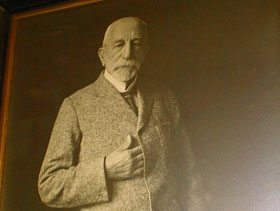
Antonio Lussich was born on June 23, 1848 and studied in the German School (Colegio Alemán) until he was 14 years old. Reading and traveling will enrich his education, as he acquires a cultural knowledge that will enable him to master five languages as his native tongue.
As a fervent member of the white national party, he enlists as a soldier in the ranks of Timoteo Aparicio´s army against General Lorenzo Batlle´s government in 1870, and in the “Tricolor revolution” in 1872, where he participates in the battle of the with the steamship General Artigas. In 1879 he marries Angela Portillo, and they have 10 children (9 girls and 1 boy).
As their father died in 1889, Antonio and Manuel Lussich buy to their brothers the shares of the ship company they inherited, keeping then the 60% Antonio and Manuel the 40%.
On October 5 1896 he purchases 1.500 hectares in Punta Ballena and begins with his major work. In 1917 he finishes with these towing, boatage and salvage labors of ´Casa Lussich´, and in this year his grey fleet is sold to the currently named National Ports Administration (Administración Nacional de Puertos). He dies in 1928, at the age of 80. Keeping with his wish, he was buried in Punta Ballena, between his plants and the sea murmur.
The sailorh
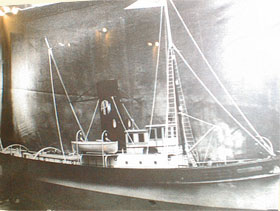 Antonio Lussich inherited of his ancestors the love for the sea and the thriving will. With his brother Manuel funded the famous salvage fleet that would set an age in the Rio de la Plata, in a period of more than forty years. The company developed and in 1882 it already had 15 schooners, ketches and yachts and its first steamship, ´el Plata´, that would be one of the most famous among Montevideans due to its incredible deeds.
Antonio Lussich inherited of his ancestors the love for the sea and the thriving will. With his brother Manuel funded the famous salvage fleet that would set an age in the Rio de la Plata, in a period of more than forty years. The company developed and in 1882 it already had 15 schooners, ketches and yachts and its first steamship, ´el Plata´, that would be one of the most famous among Montevideans due to its incredible deeds.
New motorboats and tug boats will be purchased or made in Lussich´s dry dock in order to satisfy the growing needs. The inflow of more ships to Montevideo´s Port will imply an increase of the motor boats and tug boats fleet, adding then other steamships that will also be celebrities; Emperor, Atlantico (Atlantic), Huracán (Hurricane) and Powerful.
The prestige the company acquired owing its excellent services and importers, exporters and ship owners, fed its growth, getting to have 15 steamship and tug boats and 70
 In the beginning of this century a new activity is opened, establishing a line of steamships for cargo and passengers from Montevideo, Maldonado y La Paloma, with the ships Tabare, Salvor y Cabo Polonio, taking the far-off Rocha´s lands from isolation.
In the beginning of this century a new activity is opened, establishing a line of steamships for cargo and passengers from Montevideo, Maldonado y La Paloma, with the ships Tabare, Salvor y Cabo Polonio, taking the far-off Rocha´s lands from isolation.
There were not the mentioned activities what gave Lussich a worldwide renown but its active participation in the rescue of lives, cargos and ships.
Rio de la Plata, with an intense traffic and difficult to navigate, was the scenery of numerous and tragic shipwrecks. In 1870 nearly 1500 ships from overseas were arriving to Montevideo, and the average of the shipwrecks was of more than 4 and a half per month. These figures were increasing as the maritime movement grew
For a long time Lussich was the hope of the shipwrecks and the guarantee of the recovery of the goods in danger. There are hundreds of people who owed him the salvation of their lives, and more than 200 ships were assisted between 1882 and 1917, seven per year, representing valuable capitals. The salvages started in 1884, when the little steamship Plata rescued passengers and crewmembers of the English transatlantic ´Hermes´. Much more came after: the English boats Mabel and Georgina, the steamship Amor, the Argentinean torpedo boat Rosales, the Brazilian set Pelotas, the English sailing boat Kaffir Chief, the English sets Muriel and Zarate, the French San Martin, etc, all the ships assisted in those years in the Plata, Polonio, the Lobos Island or the English Bank.
It is worth mentioning also the French transatlantic Espagne rescued in Rio de Janeiro’s bay, the vain attempt of the Corocoro in the Strait of Magallanes, the salvage of the Hazel Branch in Santa Catalina, the Hero, the Corunna, the Weybridge, etc. in front of the Arentinean coast and much more other ships..
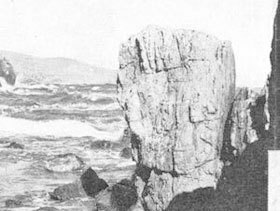 During the stormy nights in winter, specially in dangerous places, huge foreign ships with captains who didn’t know our coasts wrecked, due to faults in the hydrographical maps or in other cases to the violence of the storms in unprotected places. Lussich fleet, with its daring crewmembers, went there and performed exploits in the middle of the sea, as Lussich himself records in his interesting book, ´Famous shipwrecks”.
During the stormy nights in winter, specially in dangerous places, huge foreign ships with captains who didn’t know our coasts wrecked, due to faults in the hydrographical maps or in other cases to the violence of the storms in unprotected places. Lussich fleet, with its daring crewmembers, went there and performed exploits in the middle of the sea, as Lussich himself records in his interesting book, ´Famous shipwrecks”.
Lussich´s Grey Fleet, as it was commonly known, won popularity al along from Río de Janero to Strait of Magallanes, and decorations from England, France and Spain.
The English Cónsul, when giving Lussich a gold medal for his rendered services, said: ´…Lussich managed himself, during three nights of rough storms the salvage of this poor castaways…exposing his life, and refusing to receive compensation…It is to be noticed that the government that I have the honor to represent in this ceremony, has decorated to very few people with this medal, being considered in England of extreme value, as I believe, it is the only one given in South America´.
The Poet
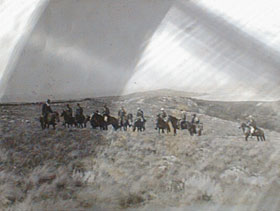 Passionate and with a romantic spirit, Antonio Lussich also sang to the majesty of the sea, the beauty of our land and the radiant powerful sun. In 1870, when he was only 22 years old, he took part in Timoteo Aparicio´s revolution. The experience he lived was registered in the gaucho-like poem ¨Los Tres Gauchos Orientales´, that saw the light on June, 1872.
Passionate and with a romantic spirit, Antonio Lussich also sang to the majesty of the sea, the beauty of our land and the radiant powerful sun. In 1870, when he was only 22 years old, he took part in Timoteo Aparicio´s revolution. The experience he lived was registered in the gaucho-like poem ¨Los Tres Gauchos Orientales´, that saw the light on June, 1872.
The poem was known by Hernandez who, six months later, published ´Martin Fierro´, pinnacle work of gaucho-like poetry. In reference with this Borges said, ´…I think it is indisputable the right of Lussich previous dialogues to be considered as a rough copy of Jose Hernandez definitive book…´
In 1873 Lussich wrote another poem, “El Matrero Luciano Santos´, that asalso very popular in the local press.
Acquisition of Punta Ballena
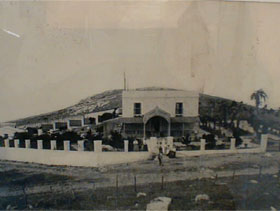 More than once, in the enjoyable visits through the valuable possession whose direction was entrusted to us some years ago, we listened from Mr.Lussich lips the story about how he got this piece of land that he populated with trees in a copious and selected way.
More than once, in the enjoyable visits through the valuable possession whose direction was entrusted to us some years ago, we listened from Mr.Lussich lips the story about how he got this piece of land that he populated with trees in a copious and selected way.
Helped by his privileged memory he started telling that in the year 1896, he had promised to a group of journalists, that when he would do an important salvage with his fleet, he would take them on a visit to Punta del Este. By chance, that year a shipwreck happened, which he with much effort got to rescue and keeping with the promise he had made to a group of prestigious editors of the most important newspapers in Montevideo, he prepared one on the tug boats and they went on it, Samuel Blixen, Arturo Brizuela among others.
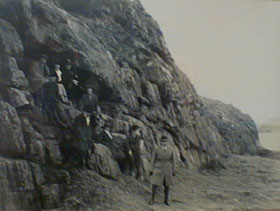 The trip couldn’t be nicer; the river offered multiple attractions as they appreciated the Uruguayan coast, so wavy, sinuous, up to where the waves arrived to dissolve in the sands o strongly hit the rocks to turn into foam. Fishing was also an attraction during the trip, but none as the sparkling and clever words of Mr.Antonio and Blixen. After several hours of slow sailing they arrived to Punta del Este, where the natural beauties were already known despite the fact that neither the railway nor the roads made it accessible to tourism, incipient then.
The trip couldn’t be nicer; the river offered multiple attractions as they appreciated the Uruguayan coast, so wavy, sinuous, up to where the waves arrived to dissolve in the sands o strongly hit the rocks to turn into foam. Fishing was also an attraction during the trip, but none as the sparkling and clever words of Mr.Antonio and Blixen. After several hours of slow sailing they arrived to Punta del Este, where the natural beauties were already known despite the fact that neither the railway nor the roads made it accessible to tourism, incipient then.
What it is today one of the most crowded seaside resorts of Rio de la Plata was then still uninhabited. The few houses had a zinc or straw roof; its walls were of mudd, and its floors of soil. Pedro Risso was there, alma mater of the place, who provided them with accommodation inviting them later to taste a typical meal. They accepted gladly and they prepared the visit.
When they got to the indicated spot they were attracted by the grandiosity of the caves, the sea, the mountains and the sands. In the presence of such a scenery, Samuel Blixen claimed: ´This is a revelation´, as Mr. Lussich retorted with studied skepticism: ´I think it is not that much´ , explaining him the reasons he had to consider it that way and trying not to pay attention anymore to everything they looked with surprise. Then Blixen, a little upset, said: ´It is known that you are not an artist´. They changed the subject. They had lunch happily. Risso, as communicative as always, told them that they were planning to sell those lands and that there was lot of people interested, himself among other as Antonio Lussich said: ´I wouldn’t pay a cent for all´. They went back to Punta del Este.
While they were in Punta del Este Antonio Lussich found out the name of who was then the owner of Punta Ballena, pretending a pain he could not dispel and announced his hasty trip to Montevideo. Naturally Samuel Blixen and his colleagues insisted on going with him but he promised formally to return soon recommending them specially to Mr.Risso.
"El Huracan" went into the sea.. Mr. Lussic arrived to Montevideo and start with the purchase of that property. He offered a few thousand pesos for those lands apparently sterile and not that propitious for any industry nor practical application. The offer was discussed and had to be rised but it was fixed at last. After several days, "El Huracan" went back to Punta del Este and they returned to Montevideo.
It hadn’t been a week when Antonio Lussich phoned Samuel Blixen and extremely happy announced him he had just bought Punta Ballena, signing the document Manuel Alonso extended. It is imaginable Mr.Blixen´s surprise, with Lussich, precisely, had discussed about the beauties of these places in the trip described previously.
The creation of the forest
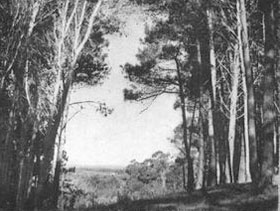 It is interesting, to study the location better, to know the geological origin and the lit logical value of the mountains in Ballena, rocky rise that like a long chain extends along from North to South to end in the renowned Punta full of caves/p>
It is interesting, to study the location better, to know the geological origin and the lit logical value of the mountains in Ballena, rocky rise that like a long chain extends along from North to South to end in the renowned Punta full of caves/p>
The sands seemed sterile and non productive and the mountains full of bulrush, weeds and other undergrowths, barely blended by some native trees, they occupied most of that possession. It was common to see some vegetable species in the wetlands surrounded by rushes, diverse ditches and dunes. But a men with strong will and enterprising spirit arrived.
Left the fleer in the coast, disembarked optimistic, examined the hidden treasures of the region and with a clear vision he sowed. Before starting the work, which took place in 1896 he consulted the best botanic and everyone coincide that he should plant only on the East side. But Angela, his wife, had already planted the first trees in the west side and the bloomed so well that Lussich, encouraged, continued planting on that side.
When the forest started having such a look, he invited the erudite botanist Arrechavaleta (who ten years before had expressed that it was a utopia plant in Punta Ballena) and showing him what he had done said ironically: ´As you can see, I followed your advice meticulously…´. The technic answered surprised: ´Antonio, this is the major refutation given to science´.
He got the most capable men in the region and his laborers teams planted the first trees, made shrubs in fabulous quantities; removed infected areas full snakes, and in every place it was said to be difficult to prosper a vegetable species, they planted and it grew with difficulties until it finally took root. At times, to plant in the wetlands, the laborers with the water up to their waists, had to make mud furnaces or little mountains and put he tiny plant on them, not to lose everything.
Contratou homens do lugar e juntos plantaram as primeiras árvores, construiram viveiros, retiraram ninhos de cobras. E em todos os lugares que se acreditava que não cresceria nada, foi plantado e com dificultades foi vingando. Para plantar nos banhados, os peốes muitas vezes com água até a cintura, tinham que fazer um montinho para proteger a muda, senão perdiam tudo.
As they ordered the plantation in the hill they already resorted to the sow system at random after a heavy rain or they opened shafts among the rocks, using strong iron bars, picks and gunpowder. It was for one of these cases that Mr.Lussich acquired certain amount of explosive near the year 1897, when the fratricidal war was threatening to take the country to the ruin and it would cost him long negotiations before the authorities for the dispatch and transfer of that material, suspecting that they could take advantage of it in the conflict. Its application was so different!. That gunpowder was supposed to open the sheer hill to put the seed or the fertile trees in it, and not to devastate people. There is no doubt that the work was not made in one day; it is reasonable to think that the efforts and expenditures retailed and that when a planting faltered another was started to substitute the first one.
Thanks to this, today pines from Japan, Mexico and Jerusalem coexist in peaceful harmony, as well as Cedars from Lebanon and from Himalaya, the silver tree, from the south of Africa, with the golden tree (Gingko Bilboa) from Japan, the native willow with the poplar from Carolina, the Indian suberous casuarinas with the American Thuya Gingantea; the indigenous Pindo with the Asian revolts cycad, among others.
According to Ernesto Villegas Suarez, who was its administrator, there are so many species and inside them such an amount of varieties there represented, ´that to its entire classification it would be necessary to dedicate much more years to investigate´.
This harmonious coexistence of trees of the most dissimilar places and climates, suggested the Uruguayan-French poet Jules Supervielle naming the wood as ´the crossroads of the antipodes´. The wood also presents the particularity of housing plants and trees that bloom in different moments of the year, guaranteeing therefore the permanent color, even in winter. Its thousands of orchids offered an amazing show. Coinciding with his friend, the sculptor Jose Luis Zorrilla de San Martín, for whom ´a wood without birds is like a flower without perfume´, Lussich brought it from all over the world.
Some roads and paths that crossed the woods in all directions were made so that it wasn´t an impenetrable forest. These marvelous woods of eight hundred hectares inspired to a famous visitant in Punta Ballena the following words: ´A famous American poet wrote ´Paradise Lost´, which was found by Lussich´.
 A significant event to be remembered: Lussich started the woods when he was 50 years old, when the life expectancy wasn’t more than 55. That explains the fact that when he crossed it, with his youngest son, Milton, he would tell him: ´what we are looking today, my son, tomorrow will be a great wood that you will be able to enjoy tomorrow… I won’t´.
A significant event to be remembered: Lussich started the woods when he was 50 years old, when the life expectancy wasn’t more than 55. That explains the fact that when he crossed it, with his youngest son, Milton, he would tell him: ´what we are looking today, my son, tomorrow will be a great wood that you will be able to enjoy tomorrow… I won’t´.
But destiny made things happen in a different way. In 1921 the President Baltasar Brum met Milton in Punta Ballena and was captivated by his friendliness. That is why when he returned to Montevideo, he asked for permission to get on a military plane and was rapidly authorized.Unfortunately, the machine fell to the ground and Milton died immediately. He was only 21 years old.
Tragic destiny
 Anybody could think that the wood created by Lussich, the one that covered him with glory, would also be the indirect seed of his major tragedy: the death of his only boy.
Anybody could think that the wood created by Lussich, the one that covered him with glory, would also be the indirect seed of his major tragedy: the death of his only boy.
His great pain was reflected in an acrostic, written in June 15, 1921, and which first part says::
Cherished Milton I dreamt I saw you
and that you hugged me with filial tenderness
raising the bitter fog
So terrible that it afflicted me
With the pain I forgot the ungodly fury
Nurturing my faith by always meeting you
Happy ad arrogant, gentle and strong
Swimming among juvenile pleasures!!
It was all an illusion... feverish dreams...!
Oh cruel destiny!! What irate death!
The firmness, the perseverance, in one of these Works, is decisive. Like this it happened..
Historic recompilation combined by Ernesto Merzario. Any reproduction must be consulted and accepted according to regulations in force.









